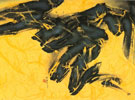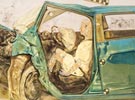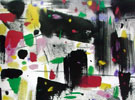Ineffable Macrocosms and Microcosms
I know that, despite his scientific background, Christopher is attracted by that which is inexpressible and mysterious, more than by classifications, exact calculations and predictions. He loves to “lose himself” in nature with an even greater abandon and pleasure than that which cities afford him.
I find that the Stèles series, which focuses on China's Yellow River Basin, shares a few elements in common with the Iceland series, to which were recently added a number of photos taken on Westman Island. I think the reason for this may be that Christopher feels more at ease in these places and they seem to perfectly echo his spirit.
It is not easy to fully grasp the reasons for our ending up in one place as opposed to another. If we exclude chance, which constitutes an easy, useless explanation, one would appear to be guided by a personal “choice,” or external motives. Instead, perhaps these factors all merge into an inner “necessity” that leads us wherever we must go so as to give us the means of undergoing certain experiences.
Christopher first visited China in the late eighties, only to make several return visits upon recognizing that this was a place that needed – and was worth taking - time to explore in order to gain a deeper knowledge and understanding of it. His reading of the poems of Segalen, a twentieth-century French writer and traveler, lead him to look beyond a facile exoticism (although Segalen did write an essay on exoticism). Still landscapes imbued with a Biblical grandeur, along with the small details of day-to-day life, in their “insipid” appearance (in the sense used by French theorist, François Jullien, in his Eloge de la fadeur), alternate in such a way as to highlight an approach that, while rarefied, is not a-temporal. Time is present, yet it is not real time, but is rather made up of the slow, weary stratification of dust that has been unsettled by car tires or blown through the desert, upon a stele bearing engraved calligraphy, a peeling fake leather armchair, or an old radio. It is as if Taylor were expressing in visual terms the Buddhist capacity to “see all the world in a grain of mustard”: the large and the small, present and past, motion and stillness, are to be found in all aspects of “reality” if one is capable of noting them, or rather, if one already finds them within oneself.
Chinese landscapes are strikingly humanized, as in the original meaning of both the Italian term, paesaggio, and the French term paysage, which “both derive from the Indo-European root, pak, which means the act of burial, thus that of cultivation, which stand to mean land that has been shaped and transfigured due to the presence of man” (Giovanni Chiaramonte). The layers of civilization have so profoundly penetrated the land that the hills have become ancient tombs, and Taylor is aware of this, albeit without having any concrete proof of it. He respects and admires the indescribable synthesis and elegance of Chinese calligraphy, which the literati ascribe to the spirit that animates all living things, even without understanding its significance.
The “pure” Icelandic landscapes, with their lack of human traces, are those in which the primeval, mysterious forces of nature are best expressed. They are also the only ones where time's passage is truly not marked by the succession of days and years, dynasties or governments, but by the wind and rain, the tides and clouds. I have at times felt so attracted to them as to ask myself whether the photographer himself does not here genuinely feel he has reached the peak of his attunement with the world. Or if, like an Italian classical painter, he attempts to include the traces of a human passage so as to render the images more familiar and less ominous. The image of an open sea, with the light sharply dividing the surface into brighter and darker areas; the dusky stretches of black sand where a wave has just retreated; distant cliffs jutting over the sea and darkly reflected upon the water's surface; or even a small dead mouse lying on a clump of soil with an air of composure in its disarming abandon. These are all images that might move the souls of those who feel they are one with the universe at its beginnings, in all its terrible grandeur, yet laden with surprising nuances and details.
It is true that an exclusive, total relationship with nature is no longer available to us, who are accustomed to living in sheltered environments. Hence the wild unpredictability of Iceland's natural habitats has been somewhat tamed. Here and there appear a road leading towards the horizon, a motocross track lined with worn car tires, or the sharp outlines of a ferryboat's bulwarks whose straight lines hem in the clouds' hazy contours.
In Iceland Christopher also follows the lives of people he knows; the singular lives of seafaring folk, or of people who have adopted a simple way of life in the midst of a harsh environment, striving to soften it with an intimate, human touch. Four spare nails on a white wall, a huge vase overflowing with fake flowers, an armchair, a simple cup...objects that remind him of someone, or of a given moment, day, or perhaps the ebb and flow of the passing days. They strike us with their air of pregnant simplicity, and we are surprised that someone would take note of them, while likewise catching our attention and leading us to consider a possibility we don't usually avail ourselves of. That of gazing upon, and allowing ourselves to be touched by, at least some of the all-too-many objects that surround us, thus considering them under a new light.
Perhaps this is one way to view Christopher's work: while the objects that he has identified stand out in stark desolation within a bare space, they are imbued with a weightiness that stems from their seeming to resonate and speak to us amid the silence.
It is up to us to hear what they are saying.
Monica Dematté
Vigolo Vattaro, 5 March 2010
Translation: Francesca Giusti




